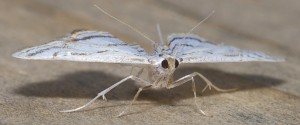After chipping ice from the minor glacier that had formed in front of our garage over the last few months and which is now thankfully beginning to melt, I walked out to the big elm tree at the end of the driveway to soak up some spring sunshine. The north side of this big tree was still banked in snow, but the south side was dry and sunlit and warm, with even a few hints of green in the dry thatch covering the bare ground. I poked around in the debris at the base of the trunk, thinking I might turn up something that was alive… Under the very first wood chip I found this bright red beetle, the color of Chinese red lacquer and flat as a fingernail. I quickly retrieved my camera and took a few photographs before it disappeared into the dark crawl spaces under the bark.
It didn’t take long to identify this beetle as a Flat Red Bark Beetle (Cucujus clavipes). The information at bugguide.net suggests its a predator of wood beetles so I’m pleased to have it reside in our old elm, no doubt there’s a good supply of food for it there. I also learned that this particular species is noted for its tolerance to extreme cold temperatures, a feat it accomplishes by producing protein antifreezes, surviving temperatures as low as -150 C in laboratory experiments, which explains why its alive and well so early in the season, mere inches from lingering drifts of snow. A brightly colored and remarkable start to the 2013 insect season.



